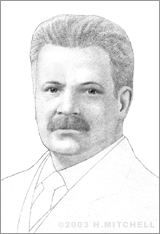Valdemar Poulsen
The now taken-for-granted system of voicemail was made possible by the work of Danish inventor Valdemar Poulsen, born on November 23, 1869 in Copenhagen. As a child he was interested in art and physics, but not mathematics, much to the dismay of his parents. They wanted him to become a doctor, but he left medical school without graduating and at age 24 took a position at the Copenhagen Telephone Company.
There Poulsen had time and opportunity to indulge in his interest in mechanics. He began experimenting with the idea of magnetizing steel wire in order to make sound recordings, seemingly spurred by early research that was available for reading at the time, though no one knows for certain what the origins of his ideas were. In 1898, he filed a patent in Denmark for the Telegraphone, the first known device to use magnetic sound recording. Poulsen’s model used a brass cylinder embedded in grooves, which would move along a wire attached to the grooves, like a trolley. Around the cylinder was wrapped a thin wire. Two poles of an electromagnet rested against the cylinder, and the magnet was energized by a battery modulated by a microphone.
The wrapping wire was magnetized in amounts corresponding to the strength of voice currents as a speaker spoke into the microphone. When a recording was complete, the battery was disconnected and a telephone receiver was connected instead. The electromagnet would return to its starting point and when freed to move along the wire again, the recording would be replayed.
In 1900, Poulsen’s Telegraphone was exhibited at the Exposition Universelle in Paris. Austrian emperor Francis Joseph spoke into it at the exhibition, and the words he spoke are believed to be the earliest surviving magnetic recording. In 1903, Poulsen founded the American Telegraphone Company with some associates from the U.S. to manufacture the devices, which were used mainly for office dictation and telephone message recording. Subsequent to Poulsen’s invention, many began creating their own recording devices and making improvements to his original technology. In 1927, J. A. O'Neill replaced the wire with a magnetically coated ribbon, which would later dominate the recording industry.
Meanwhile Poulsen continued to work on communications technologies. In 1903, he developed an arc transmitter, which enabled speech to be transmitted up to a radius of 150 miles. This was a significant improvement over the arc transmitter invented by William Duddell in 1900; by 1920, Poulsen’s arc transmitter had the power to transmit speech up to 2,500 miles. Poulsen also worked on the first version of the hard disk. His steel disk had a raised spiral on its surface which was traced by an electromagnet as the disk rotated.
Poulsen died in July, 1942. He was well respected by the scientific community, and held the Gold Medal of the Royal Danish Society of Science and the Danish Government Medal of Merit. He was also a Fellow of the Danish Academy of Technical Science and the Swedish Institute for Engineering Research, and he held an Honorary Doctoral degree from the University of Leipzig.


